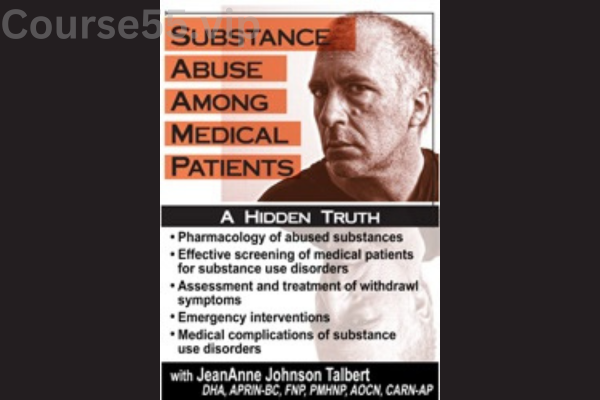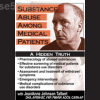Substance Abuse Among Medical Patients: A Hidden Truth By JeanAnne Johnson Talbert – PESI
$199.00 Original price was: $199.00.$23.10Current price is: $23.10.
Substance Abuse Among Medical Patients: A Hidden Truth – Digital Download!

Substance Abuse Among Medical Patients: A Hidden Truth By JeanAnne Johnson Talbert – PESI
Overview

Substance Abuse Among Medical Patients: An Overlooked Crisis
Substance abuse has long remained a hidden issue in healthcare, often escaping the attention of medical professionals. Jeananne Johnson Talbert’s compelling book, Substance Abuse Among Medical Patients: A Hidden Truth, leverages her vast experience as a psychiatric and mental health nurse practitioner to explore this critical yet under-discussed topic. With more than 25 years in the field, Dr. Talbert examines how substance use disorders (SUDs) complicate medical treatment and influence patient outcomes in various healthcare settings, from routine hospital visits to high-risk scenarios such as pregnancy and surgical recovery. This book seeks to deepen healthcare providers’ understanding of these challenges, ultimately fostering more effective patient care.
The Complex Nature of Substance Abuse in Medical Settings
Substance use disorders among hospitalized patients present a multifaceted problem that demands thorough investigation. Dr. Talbert’s book highlights the significant prevalence of drug and alcohol misuse among those receiving medical care, revealing how these conditions can disrupt treatment outcomes. For example, in surgical cases, substance abuse can prolong recovery times, elevate risks of post-operative complications, and even increase mortality rates.
The scope of these issues underscores the urgency for medical practitioners to proactively assess and address substance use in their patients. Through a detailed analysis of epidemiological data, Dr. Talbert exposes the widespread nature of substance abuse in medical environments. This research serves as an urgent reminder for healthcare professionals to engage more deeply with patients, particularly those exhibiting warning signs of substance dependence.
Recognizing substance use disorders in clinical settings poses a significant challenge. Many healthcare providers lack the necessary training or screening tools, which allows these conditions to go undiagnosed. Dr. Talbert offers practical guidance for early identification, emphasizing the importance of patient-provider communication to encourage honest discussions about substance use.
Key Statistics on Substance Use Disorders in Medical Patients
| Substance | Estimated Prevalence in Medical Patients | Associated Health Risks |
|---|---|---|
| Alcohol | 15-20% | Liver disease, post-surgical complications |
| Opioids | 10-15% | Respiratory depression, dependency risks |
| Stimulants | 5-10% | Cardiovascular issues, increased mortality |
These statistics emphasize the necessity of incorporating routine substance abuse screenings into standard medical care.
The Pharmacological Impact of Substance Abuse
Understanding the physiological effects of commonly misused substances is crucial for proper diagnosis and treatment planning. Dr. Talbert stresses that medical professionals must be well-versed in the pharmacological properties of alcohol, opioids, and stimulants to ensure effective patient care.
She explains the fundamental principles of pharmacokinetics and pharmacodynamics, which help clarify how substances interact with the body over time. For instance, alcohol initially acts as a depressant but leads to increased tolerance and dependency with prolonged use. Similarly, opioids, while effective for pain management, pose a high risk of addiction and respiratory failure.
For optimal patient care, clinicians must anticipate withdrawal symptoms and potential drug interactions. A strong understanding of these pharmacological effects allows providers to deliver safer, more informed treatments, ultimately reducing complications associated with substance use.
Effects of Commonly Abused Substances
| Substance | Short-Term Effects | Long-Term Consequences |
|---|---|---|
| Alcohol | Relaxation, euphoria | Dependency, liver failure |
| Opioids | Pain relief, sedation | Tolerance, overdose risk |
| Stimulants | Increased energy, alertness | Anxiety, cardiovascular disease |
This information reinforces the importance of closely monitoring patients with known or suspected substance use disorders.
Screening and Diagnostic Approaches
One of the central messages of Dr. Talbert’s book is the necessity for healthcare providers to implement effective screening tools tailored to identifying substance use disorders. When equipped with the right assessment techniques, clinicians can create an environment of trust that encourages patients to disclose their struggles with substance use.
Dr. Talbert highlights motivational interviewing as a particularly effective method for initiating conversations with patients. This approach fosters open dialogue by using empathetic and non-confrontational questioning, reducing patient defensiveness and increasing the likelihood of accurate self-reporting.
Additionally, she stresses that bias-free screening is critical. Stigmatization can discourage patients from disclosing substance use, ultimately hindering effective treatment. Healthcare providers must remain aware of any unconscious prejudices they may hold and instead focus on patient-centered, compassionate care.
Key Screening Strategies
- Motivational Interviewing: Uses open-ended questions to facilitate patient honesty.
- Standardized Screening Tools: Instruments like the CAGE questionnaire help quickly identify substance use issues.
- Non-Judgmental Approach: Ensures patients feel comfortable discussing sensitive information.
By implementing these methods, medical professionals can enhance early detection and intervention, ultimately improving patient outcomes.
Addressing Dual Diagnosis in Substance Use Patients
One of the most complex aspects of treating patients with substance use disorders is the high prevalence of dual diagnosis—the co-occurrence of mental health conditions and substance dependence. Dr. Talbert highlights the necessity of addressing both issues concurrently rather than treating them as separate conditions.
Patients with dual diagnoses often experience heightened challenges, including increased treatment resistance, higher relapse rates, and greater healthcare costs. Therefore, integrated care approaches are essential for improving recovery outcomes. Healthcare providers must adopt a multidisciplinary treatment framework that considers both mental health and substance abuse treatment simultaneously.
For example, a patient experiencing depression may turn to alcohol for temporary relief, inadvertently exacerbating their symptoms over time. Recognizing these interrelated conditions allows medical teams to implement targeted interventions that address both the psychological and physiological components of addiction.
Best Practices for Dual Diagnosis Treatment
- Coordinated Care Plans: Involve collaboration between substance abuse specialists and mental health professionals.
- Provider Training: Educate clinicians on how to manage co-occurring disorders effectively.
- Continuous Monitoring: Conduct routine evaluations to track progress in both areas.
These strategies promote a comprehensive treatment approach that maximizes patient recovery potential.
A Call to Action for Healthcare Providers
Beyond presenting clinical insights, Substance Abuse Among Medical Patients: A Hidden Truth serves as a call to action for medical professionals. Dr. Talbert urges healthcare providers to challenge their biases and advocate for more inclusive, supportive care for patients with substance use disorders.
Stigma remains one of the largest barriers to effective treatment, often resulting in disparities in healthcare access and continuity of care for substance-abusing patients. Education and training are essential in shifting attitudes and fostering a healthcare system that prioritizes understanding over judgment.
Dr. Talbert also emphasizes the importance of policy advocacy—urging medical institutions to adopt reforms that support patients struggling with substance use disorders. Systemic changes, such as integrating routine screenings into primary care and expanding access to specialized addiction treatment programs, could significantly improve long-term outcomes.
Final Thoughts
Jeananne Johnson Talbert’s Substance Abuse Among Medical Patients: A Hidden Truth serves as an essential resource for healthcare professionals seeking to enhance their understanding of substance use disorders. Through a combination of data-driven insights, real-world case studies, and practical intervention strategies, the book offers valuable guidance on identifying and managing addiction within medical settings.
The urgent need for compassionate, evidence-based care cannot be overstated. By implementing the strategies outlined in Dr. Talbert’s work, medical professionals can play a crucial role in improving patient outcomes, reducing stigma, and fostering a more inclusive healthcare environment for individuals battling substance use disorders.
Frequently Asked Questions:
Business Model Innovation: We operate a group buying strategy, allowing participants to share costs and access popular courses at reduced prices. This model benefits individuals with limited financial resources, despite concerns from content creators about distribution methods.
Legal Considerations: The legality of our operations involves complex issues. Although we don’t have explicit permission from course creators to resell their content, there are no specific resale restrictions stated at the time of purchase. This ambiguity creates an opportunity for us to provide affordable educational resources.
Quality Control: We ensure that all course materials purchased are identical to those offered directly by the creators. However, it’s important to understand that we are not official providers. As such, our offerings do not include:
– Live coaching calls or sessions with the course author.
– Access to exclusive author-controlled groups or portals.
– Membership in private forums.
– Direct email support from the author or their team.
We aim to reduce the cost barrier in education by offering these courses independently, without the premium services available through official channels. We appreciate your understanding of our unique approach.
Be the first to review “Substance Abuse Among Medical Patients: A Hidden Truth By JeanAnne Johnson Talbert – PESI” Cancel reply
You must be logged in to post a review.

 Barb Stepp’s NLP Master Practitioner By Barbara Stepp
Barb Stepp’s NLP Master Practitioner By Barbara Stepp  Acceptance and Commitment Therapy (ACT) Made Easy: Innovative Techniques for Depression, Anxiety, Trauma & Personality Disorders By Douglas Fogel - PESI
Acceptance and Commitment Therapy (ACT) Made Easy: Innovative Techniques for Depression, Anxiety, Trauma & Personality Disorders By Douglas Fogel - PESI 















Reviews
There are no reviews yet.